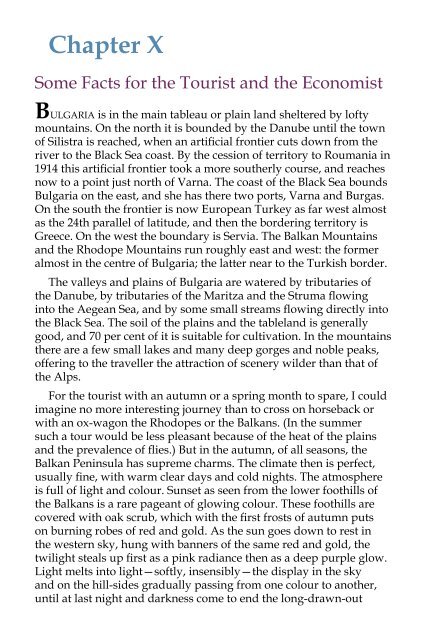Bulgaria e-book - iMedia
Bulgaria e-book - iMedia
Bulgaria e-book - iMedia
You also want an ePaper? Increase the reach of your titles
YUMPU automatically turns print PDFs into web optimized ePapers that Google loves.
Chapter X<br />
Some Facts for the Tourist and the Economist<br />
<strong>Bulgaria</strong> is in the main tableau or plain land sheltered by lofty<br />
mountains. On the north it is bounded by the Danube until the town<br />
of Silistra is reached, when an artificial frontier cuts down from the<br />
river to the Black Sea coast. By the cession of territory to Roumania in<br />
1914 this artificial frontier took a more southerly course, and reaches<br />
now to a point just north of Varna. The coast of the Black Sea bounds<br />
<strong>Bulgaria</strong> on the east, and she has there two ports, Varna and Burgas.<br />
On the south the frontier is now European Turkey as far west almost<br />
as the 24th parallel of latitude, and then the bordering territory is<br />
Greece. On the west the boundary is Servia. The Balkan Mountains<br />
and the Rhodope Mountains run roughly east and west: the former<br />
almost in the centre of <strong>Bulgaria</strong>; the latter near to the Turkish border.<br />
The valleys and plains of <strong>Bulgaria</strong> are watered by tributaries of<br />
the Danube, by tributaries of the Maritza and the Struma flowing<br />
into the Aegean Sea, and by some small streams flowing directly into<br />
the Black Sea. The soil of the plains and the tableland is generally<br />
good, and 70 per cent of it is suitable for cultivation. In the mountains<br />
there are a few small lakes and many deep gorges and noble peaks,<br />
offering to the traveller the attraction of scenery wilder than that of<br />
the Alps.<br />
For the tourist with an autumn or a spring month to spare, I could<br />
imagine no more interesting journey than to cross on horseback or<br />
with an ox-wagon the Rhodopes or the Balkans. (In the summer<br />
such a tour would be less pleasant because of the heat of the plains<br />
and the prevalence of flies.) But in the autumn, of all seasons, the<br />
Balkan Peninsula has supreme charms. The climate then is perfect,<br />
usually fine, with warm clear days and cold nights. The atmosphere<br />
is full of light and colour. Sunset as seen from the lower foothills of<br />
the Balkans is a rare pageant of glowing colour. These foothills are<br />
covered with oak scrub, which with the first frosts of autumn puts<br />
on burning robes of red and gold. As the sun goes down to rest in<br />
the western sky, hung with banners of the same red and gold, the<br />
twilight steals up first as a pink radiance then as a deep purple glow.<br />
Light melts into light—softly, insensibly—the display in the sky<br />
and on the hill-sides gradually passing from one colour to another,<br />
until at last night and darkness come to end the long-drawn-out<br />
procession of colour.<br />
These wild mountains abound in game which has been driven<br />
from the tamer parts of Europe. There are bears, wolves, jackals, wild<br />
boars, deer, chamois; and all kinds of birds, such as eagles, falcons,<br />
bustards, wild geese, pheasants, partridges, woodcock, snipe, and<br />
moorhen. For the sportsman the Balkan Peninsula is almost the<br />
only tract left in Europe offering really wild game. King Ferdinand,<br />
who recognises the tourist possibilities of his country, has lately<br />
encouraged the stocking of the Rhodope streams with trout, to offer<br />
another attraction to the visitor.<br />
Guarding the Flocks and Herds





